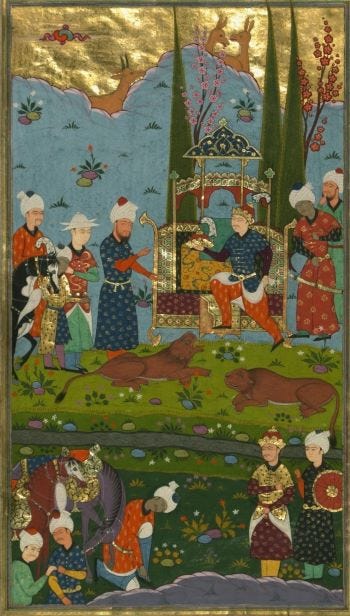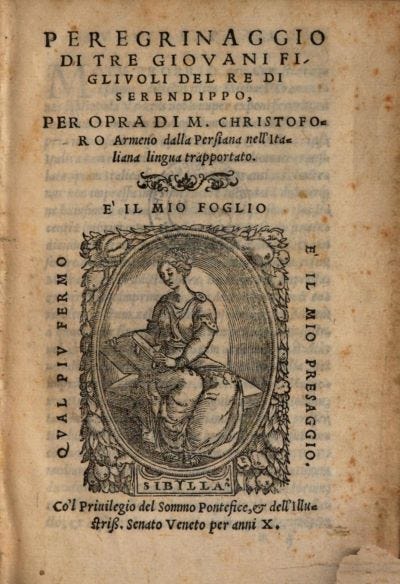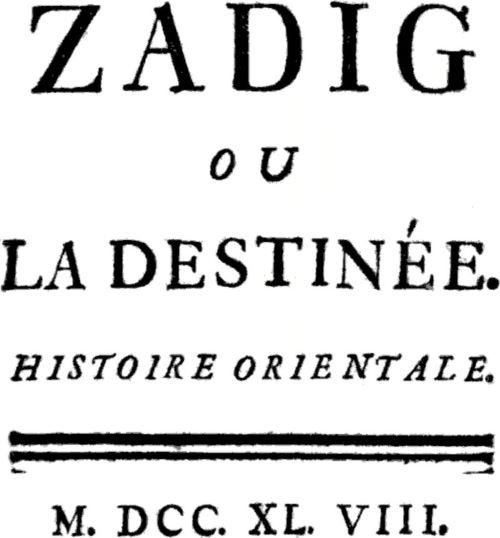Voltaire’s Unexpected Influence on My Detective Fiction
How I chanced upon a whimsical Enlightenment classic, of Persian origin
So many wonderful coincidences arise while researching and writing a novel that they can almost seem, well, fated. At least, there is a sense of déjà vu to the complementary symmetries that reveal themselves over time during the adventure.
One good example, in my case, cane with Voltaire (whose birthday falls today), In this article, we’ll celebrate a great work by the man born François-Marie Arouet on 21 November 1694 in Paris.
Voltaire (his pen name) was among the most influential French Enlightenment writers, satirists and political philosophers. However, today’s article is not about Voltaire’s political philosophy, or his famous Candide; rather, it’s on his contribution to detective fiction, in a riotously comic philosophical novella of 1747, Zadig—itself, based partly on an Italian adaptation of older Persian narratives.
This odd coincidence was actually among the most important moments in my novel research, as it suffused the whole Detective Grigoris book with a certain spirit of C’est la vie that reflects the quick changes of fortune for my detective and his fellow characters during the novel.
Edgar Allan Poe and My Original Discovery of Zadig
As you may recall from last month’s article on Poe, from late 2021, I studied the origins of detective fiction. I aspired in the (probably fatal) hopes of creating something new in the then-vestigial Detective Grigoris project.
The Wikipedia page on Poe’s “The Murders in the Rue Morgue” (Graham’s Magazine, 1841) was among my first stops, as this ‘tale of ratiocination’ (as Poe called his method of logic) is among the first detective stories, introducing the world to his ingenious and eccentric French reasoner, C. Auguste Dupin. Wikipedia notes that Voltaire’s main character “performs similar feats of analysis, themselves borrowed from The Three Princes of Serendip, an Italian rendition of Amir Khusro's "Hasht-Bihisht.”’
The Missing Camel, Voltaire’s Dog-and-Pony Show, and Poe’s Methodical Usage
That quote’s from Robert K. Merton’s 2006 book, The travels and adventures of serendipity: a study in sociological semantics and the sociology of science (Princeton, p. 16). Merton discusses how the aristocratic and diplomatic classes of 16th-century Venice were curious about the languages, tales and cultures of the exotic East. The personal contacts and travels of the maritime trade-focused Republic also meant that cultural connections could flourish, introducing writing and translation to Italy. We’ve already seen this trend with the bibliographical case of the Byzantine émigré, Cardinal Bessarion.
In 1557, Venetian publisher Michele Tramezzino released the tale (now known in English as The Three Princes of Serendip) as Peregrinaggio di tre giovani figliuoli del re di Serendippo.
This derived from the Persian translation of a certain Cristoforo Armeno, an Armenian émigré from Tabriz. A friend of the Italian publisher’s nephew, Armeno worked for the Venetians as a translator of Oriental languages.
Cristoforo Armeno translated a part of Khusro’s 1302 poem, "Hasht-Bihisht” (“The Eight Paradises”), which has a The Thousand-and-One Nights sensibility. One of several in the epic tradition based on folk tales about 5th-century Sassanian Persian King Bahram V, Khusro’s work seems the first to include the ‘three princes of Serendip’ and the missing camel story for which they are famous in detective fiction. As English translations are few, the Italian work descended through the French tradition, and most famously, Voltaire’s partial adaptation in Zadig.
The word ‘serendip’ in classical Persian refers to Sri Lanka/Ceylon. The story unfolds in an ancient land, where the king hires tutors for his three princely sons. When none of the princes accept his offer to replace him, each protesting his superior sagacity, the wise king decides to send the princes abroad to test their book-learning with experience.
Here the story devolves into comic disrepair before reassembling for a happy ending. The brothers discover clues that allow them to claim to identify a missing camel—one that they’ve never actually seen. These clues are so precise and bizarre that the princes are soon arrested on suspicion of having stolen the absent camel. They answer for their unbelievable knowledge to their captors with this logic:
“Grass had been eaten from the side of the road where it was less green, so the princes had inferred that the camel was blind on the other side. Because there were lumps of chewed grass on the road that were the size of a camel's tooth, they inferred they had fallen through the gap left by a missing tooth. The tracks showed the prints of only three feet, the fourth being dragged, indicating that the animal was lame. That butter was carried on one side of the camel and honey on the other was evident because ants had been attracted to melted butter on one side of the road and flies to spilled honey on the other.”

In his 1747 work (published in French as Zadig, ou La Destinée), Voltaire tells numerous intertwined tales about the fortunes and misfortunes of his eponymous protagonist, a Zoroastrian philosopher of Babylonia, as he travels far and wide, enjoying both honors and absurd misfortunes. But in the relevant chapter 3, Voltaire disguises his own textual thievery; he replaces the lost camel with a missing horse and dog that his comic hero, Zadig has never seen, in a sort of circular economy of live-and-let-live Enlightenment wit. Voltaire’s adventurer defends himself at court by saying:
“…I perceiv’d upon the Sand the Footsteps of an Animal, and I [27]easily inferr’d that it must be a little one. The several small, tho’ long Ridges of Land between the Footsteps of the Creature, gave me just Grounds to imagine it was a Bitch whose Teats hung down; and for that Reason, I concluded she had but lately pupp’d. As I observ’d likewise some other Traces, in some Degree different, which seem’d to have graz’d all the Way upon the Surface of the Sand, on the Side of the fore-Feet, I knew well enough she must have had long Ears. And forasmuch as I discern’d; with some Degree of Curiosity, that the Sand was every where less hollow’d by one Foot in particular, than by the other three, I conceiv’d that the Bitch of our most august Queen was somewhat lamish, if I may presume to say so.”
The historic influence-association between Voltaire’s reframing of the Italian narration of the Persian tale has in turn been deemed influential for Poe. Indeed, Dupin’s application of method becomes more refined in his story. As Poe defines it: “the extent of information obtained lies not so much in the validity of the inference as in the quality of the observation." The introduction of observation as a key principle would of course be used by most subsequent genre authors.
Beyond Deduction: Zadig and Life’s Comic Vicissitudes as a Philosophical Lesson
Departing for now from the general genealogy of detective fiction, there were even more remarkable aspects of this literary discovery awaiting me. The fact that not only Western detective-fiction has ancient Persian DNA was not only fascinating in itself; further, the timing of my discovery was, well, serendipitous.
Indeed, I discovered this fact exactly at the moment I was trying to work out how my own, preconceived Persian element of the Detective Grigoris third chapter would play out. The fact that I read this from Zadig, which is subtitled, or, a Book of Fate still seems magically sound.
While I would not get the full answer to my plot question until late in the editing process, in the early summer of 2024, the initial stimulus I needed was provided in the hours of listening and laughing to recitations of Zadig while researching and simultaneously writing.

This is worth a comment, as Voltaire’s wonderful wit and juxtapositions of unbelievable fortune and calamity in quick succession, often with great allegorical and rhetorical cleverness, deserve to be read and celebrated. However, I don’t speak French, and the limited space of Substack is not ideal even for quotations from Zadig. The book’s tales are all entangled, the available translation (like the bit quoted above) is archaic, and the audio-recitations too fail to do Voltaire justice. Still, if you’d like to read Zadig, the full text exists here on Project Gutenberg. (There are more recent translations on for sale on Amazon, but I can’t judge their quality as I haven’t bought them).
Final Comments on Chesterton, Missing Elements, French Fashion and the Recycling of Culture
Beyond the element of inference-from-observation for which Poe is associated with Voltaire (and the Italian retelling of the Persian tale before them) is the similar ingenious pattern of G.K. Chesterton’s “The Blue Cross” (1910), which I covered here in late April 2023.
What I realized, though I didn’t write it then, was that Chesterton had inverted the concept of the Persian fairy tale; instead of seekers of knowledge describing objects they had not seen, and one that others brought to their attention first, Chesterton went and hid the story’s fundamental relationship of knowledge, from most of the characters and all of the readers.
It is from the convergence of these twin realizations that my cogitating began. I shall avoid spoilers, but I simply mention these things since, as time passes and people grow forgetful or facts are lost, it is handy to have a record of the creation of the work, the order of things. Even if this explanation is admittedly gnomic, it will stand my readers well in future.
The last amusing coincidence of my research misadventure with Zadig was another simultaneous discovery—that, yes, an overpriced French fashion brand named Zadig & Voltaire has existed since 1997. I know not if the late Jean Baudrillard ever had a definite opinion about the company and its naming strategy, but I doubt he’d be very impressed by what seems a rather terme simulation of a simulation of what 21st-century French fashion might be considered. But then again, I’m neither French nor fashion-conscious.
Actually, even as I write this thought out, chumming the recherché waters for detective-fiction bites, I’ve just found an appropriate marker of our dawning age. I repeat, in another and less elliptical manner: it is not important when something is written, but when it is rediscovered and repurposed.
That’s the spirit of the time of Voltaire’s readers, and true today also. My present discovery derives from Gerry Coulter’s 2013 essay about the French postmodernist philosopher’s views on fashion.
“In his earlier writings,” the scholar writes. Baudrillard “said that fashion is very important to the system in that it continually ‘announces the myth of change’ in a manner essential to our contemporary circumstance: ‘Modernity is not the transmutation of all values but the commutation of all values, their combination and the ambiguity. Modernity is a code, and fashion is its emblem.’”
Fashion as the emblem of Modernity’s code? I can already see my detective-character’s mind gearing up for a comedic protest. But there is more to say: for, the same 1976 article adds that “Baudrillard found fashion to be an important place for the recycling of the desire for death: ‘…emptying it of every subversive phantasm and involving it, along with everything else, in fashion’s innocuous revolutions.’”
I will keep such essays as notes-to-self, along with all those accumulated Zadig & Voltaire marketing newsletters since 2022. For even (especially?) in the most banal of marketing copy, one can find traces of the axiomatic, by which Chesterton so astutely marked out his Parisian detective Valentin’s specific mental approach to his task. And if this British author’s jocund generalization does not at its core owe to Voltaire, I cannot imagine from where it could have come. It seems to have a universal application, at least as concerns French thought.
As nothing that is experienced is wasted, expect my Detective Grigoris to have critiqued both fashion and philosophy (and even, philosophies of fashion) in a future story—one that has nothing to do with either. It exists, and will be set to take place in Detective Grigoris novel 2.
And so, thanks to Voltaire and my fortune partaking in research—research that is ceaselessly present—I can now say the this future story’s entire scenario was envisioned even before I’d heard of Zadig or the French fashion company anmed after it.
If we cannot control time, or go back in it, this sort of course-correction of things in time brings a certain substitute for joy: we delight in observation, of that which the collective has already seen in other forms, even if they cannot recall ever having seen it, much less describe it.
Endless they are indeed, the grains of sand concealing that long-lost camel.






Wonderful ruminations! And points to much more reading. Makes me wonder if we’ll ever discover the first detective story.
Great story Christoforo!! I've seen the brand name Voltaire & Zadig without knowing of its origins, much less the product! I look forward to reading Zadig & your Grigoris story.